The water delivery person delivers three and five gallon
bottles of water (the majority of the bottles are five gallons) to a
variety of residential and commercial customers. The bottles are placed in
square individual crates so they can be stacked on pallets within the bays
of the truck.
|
|
Potential
Hazard:
- Employees perform frequent
torso bending (Fig. 1) when placing bottles of water at ground
level or when loading the hand truck for transport.
|
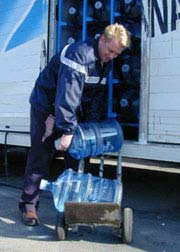
Fig. 1:
Bending
to place bottles
on hand
truck.
|
Possible Solutions:
- Providing a
handle at the top of the bottle (Fig. 2) near the
water release nozzle will allow employees
to lower the bottle without placing either of the
hands on the bottom. This
should reduce the amount of torso bending needed
during the lowering process.
- Educate the employee on the
basics of body biomechanics and the importance of
maintaining the back in an ergonomically neutral
position. Generally, the torso should not bend
more than 6 to 10 degrees from vertical.
|
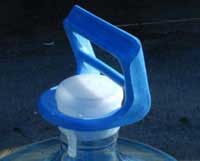
Fig. 2:
Bottle Handle.
|
|
|
|
Potential
Hazard:
- Employees use repeated,
elevated reaches (Fig. 3) to access bottles on the top levels of
the palletized water containers.
|
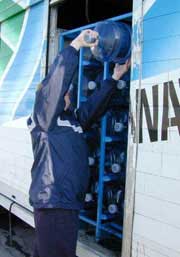
Fig.
3:
Elevated reaching to
access bottles.
|
Possible Solution:
- Reduce the distance employees
must reach to access bottles. The arms should be
bent and kept in close to the body. Eliminate the
fifth row
of bottles if at all possible. Reaches should be
limited to no more than 16 to 17 inches horizontally
and the hands should not need to be raised above head
height to remove items from the truck.
|
|
|
Potential
Hazard:
- Bottle crates are usually
stacked two deep within the bays of the delivery truck
(Fig. 4). This arrangement forces the employee to use
long extended reaches to access bottles at the back of
the bay and to lift some of
the heavy loads at long distances from the torso. This
creates a strain on the low back and shoulders.
|
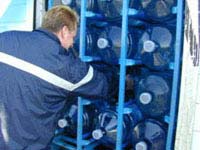
Fig. 4:
Bottles stacked two
rows deep in the bay.
|
Possible Solutions:
- Whenever possible, use two employees (Fig. 5). The use of two
employees when using proper lifting techniques will
generally reduce the hazard of most lifts.
- Use an articulated arm or other lifting
mechanism to lower and position heavy objects.
|
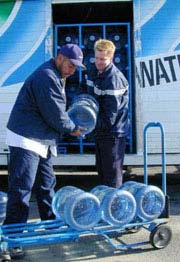
Fig. 5:
Two employees are
better than one.
|
|
|
|
Potential
Hazard:
- Not having bottle racks at the delivery site prevents employees from delivering and lifting the bottles at ergonomically desirable
heights.
|
Possible Solution:
- Provide the customer with
bottle racks at the delivery site (Fig. 6) so employees
can deliver the bottles at ergonomically desirable
heights. Store empty bottles on the top and bottom
shelves, and full bottles in the
middle shelves. The employees and the customer would
both benefit since heavy lifts would be performed at ergonomically desirable heights.
|
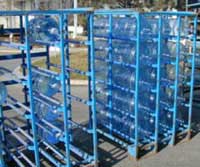
Fig. 6:
Bottle Racks.
|
|
|
|
Potential
Hazard:
|
Loading bottled water onto water coolers exposes
employees to several risks.
A bottle weighs approximately 48 pounds. To load a bottle,
the employee must lift it up, over and onto the water cooler (while trying
to avoid spilling the bottle). This is an awkward task that
places strain on the employee's back, shoulders, arms and legs (Fig.
7-8). Another hazard is that employees may slip and fall as
a result of spilled water.
|
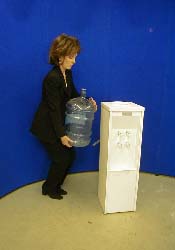
Fig. 7 |
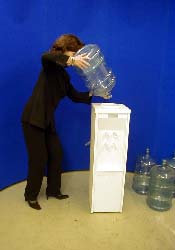
Fig. 8 |
Possible
Solution:
Provide a bottled water installer (Fig 9-12). The battery operated, rechargeable machine transports, lifts and loads
five gallon bottles. The machine handles the transporting, lifting and loading of the
bottles, thus eliminating exposure to heavy lifting and water
spillage.

Fig. 9:
wheel machine to bottle storage area and tilt bottle onto cradle |

Fig. 10:
close-up of bottle being tilted onto cradle |

Fig. 11:
place straps around bottle and close buckle |

Fig. 12:
place stopper over bottle opening |

Fig. 13:
wheel bottle in front of cooler |

Fig. 14:
press load button |

Fig. 15:
machine begins tilting bottle up |

Fig. 16:
machine flips the bottle as it reaches the top |
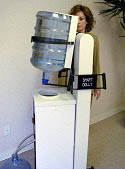
Fig. 17:
bottle is about to be loaded onto cooler |

Fig. 18:
stopper arm moves away just as water is loaded |

Fig. 19:
bottle is safely loaded onto water cooler |

Fig. 20:
release buckle and wheel away from cooler |
Notes:
Information on the problem of loading bottled water can be found on Lawrence Livermore National Laboratory's web site under Lessons Learned - Safety Alerts.
The National Safety Council has a job analysis video series narrated by William
Shatner. One of the safety hazards discussed is loading bottled water.
|
|
